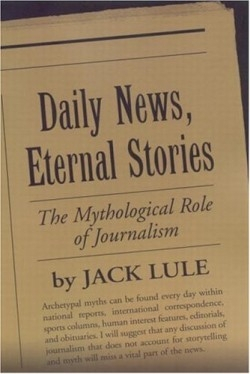Daily News, Eternal Stories
The Mythological Role of Journalism
Chances are the average reporter for the Hometown Gazette, banging out his umpteenth story about the city council’s feud over funding a new sewer system, doesn’t exactly regard himself as a latter-day Homer. Lule would advise the ink-stained wretch not to sell himself short. He argues that, while light years short of the Greek poet’s artistic majesty, today’s journalists are nonetheless his lineal descendants. They are modern incarnations of the ancient storytellers who conceived and spread the myths that have helped countless generations make sense of an often unfathomable world. For, whether we realize it or not, many newspaper stories are nothing less than current versions of age-old tales of good and evil, victory and defeat.
Lule is no media-basher, accusing the papers of peddling fiction. The former reporter and current journalism professor at Lehigh University defines myth, not as falsehood, but as “the great stories of humankind for humankind”—eternal themes played out in ephemeral, day-to-day life. Aware that practical-minded journalists might dismiss his thesis as ivory tower fluff, he attempts to prove it by analyzing how The New York Times—“our society’s privileged and preeminent storyteller”—has covered stories involving mythological archetypes.
Consider, for example, the hero—one of seven “master myths” Lule identifies. Just as Homer chronicled the exploits of Odysseus, the Times closely followed baseball star Mark McGwire’s pursuit of Roger Maris’ single-season record of sixty-one homeruns in 1998. Its daily stories and occasional profiles placed him squarely within the heroic tradition, portraying him as born into humble surroundings, embarking on a great quest, courageously plunging into battle and facing setbacks, yet prevailing against daunting odds. The Times has dealt similarly with other news subjects fitting into mythological molds, such as boxer Mike Tyson (“the trickster”); Leon Klinghoffer, murdered by Palestinian terrorists in 1985 (“the victim”); and Hurricane Mitch’s devastation of Central America (“the flood”).
Lule makes a strong case for his intriguing and original premise. His writing is lively, his research exhaustive, his case studies illuminating. Still, what practical lessons does he offer for workaday journalists? The author contends that viewing news coverage from the mythmaking perspective is essential for resolving what is widely seen as a crisis of relevance and purpose in the profession. He may well be right, yet for that Hometown Gazette reporter simply worried about making tonight’s deadline, it could be a tough sell.
Reviewed by
John Flesher
Disclosure: This article is not an endorsement, but a review. The publisher of this book provided free copies of the book to have their book reviewed by a professional reviewer. No fee was paid by the publisher for this review. Foreword Reviews only recommends books that we love. Foreword Magazine, Inc. is disclosing this in accordance with the Federal Trade Commission’s 16 CFR, Part 255.

